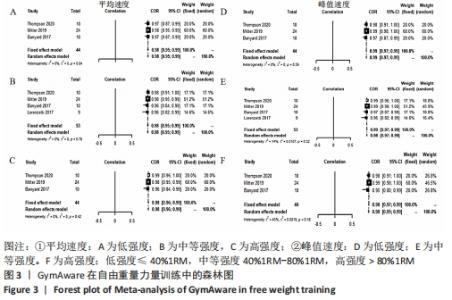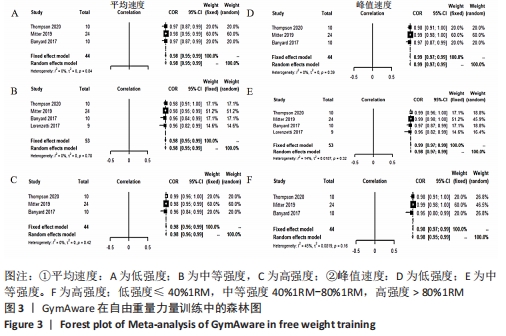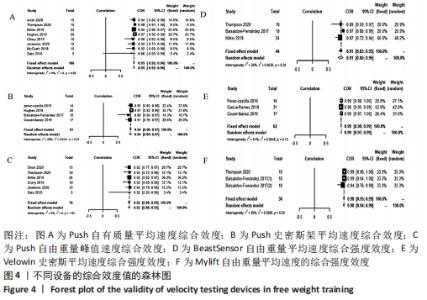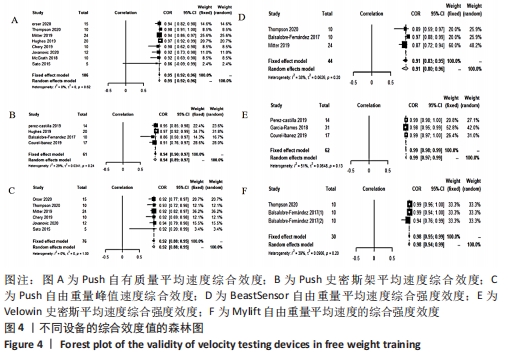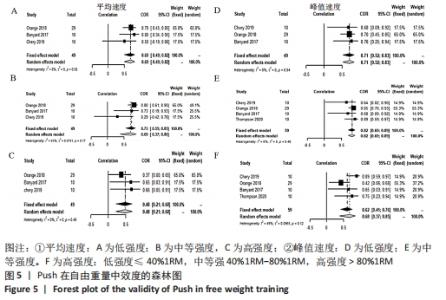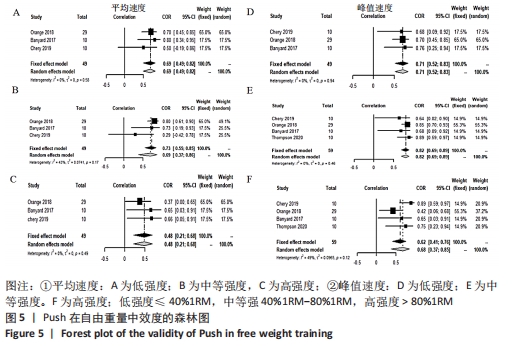Chinese Journal of Tissue Engineering Research ›› 2023, Vol. 27 ›› Issue (14): 2266-2275.doi: 10.12307/2023.428
Previous Articles Next Articles
Validity of commercial portable velocity testing devices in strength training: a systematic review and Meta-analysis
Liao Kaifang1, 2, Zhang Guochao2, Gu Zhengqiu2, Li Yongming2, 3
- 1School of Exercise Healthy, Guangdong Vocational Institute of Sports, Guangzhou 510663, Guangdong Province, China; 2School of Physical Education and Sport Training, Shanghai University of Sport, Shanghai 200438, China; 3China Institute of Sport Science, Beijing 100061, China
-
Received:2022-06-15Accepted:2022-06-30Online:2023-05-18Published:2022-09-30 -
Contact:Li Yongming, Professor, Doctoral supervisor, School of Physical Education and Sport Training, Shanghai University of Sport, Shanghai 200438, China; China Institute of Sport Science, Beijing 100061, China -
About author:Liao Kaifang, PhD candidate, School of Exercise Healthy, Guangdong Vocational Institute of Sports, Guangzhou 510663, Guangdong Province, China; School of Physical Education and Sport Training, Shanghai University of Sport, Shanghai 200438, China -
Supported by:the National Key Research and Development Program for “Science and Technology Winter Olympics” Key Special Project, No. 2018FF0300901 (to LYM)
CLC Number:
Cite this article
Liao Kaifang, Zhang Guochao, Gu Zhengqiu, Li Yongming. Validity of commercial portable velocity testing devices in strength training: a systematic review and Meta-analysis[J]. Chinese Journal of Tissue Engineering Research, 2023, 27(14): 2266-2275.
share this article
Add to citation manager EndNote|Reference Manager|ProCite|BibTeX|RefWorks
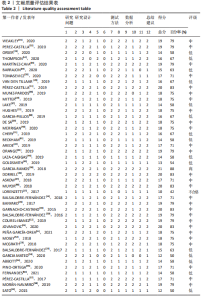
2.1 文献筛选结果 从3个数据库中总计检索出469篇潜在相关文献,删除其中重复文献109篇后,通过阅读标题和摘要,剔除明显不符合纳入标准的文献302篇。对剩余的58篇进行全文阅读和分析,并筛查文献的参考文献部分取回18篇相关文献。因此,总计对76篇文献进行全文筛查,删除不符合纳入标准的32篇文献后,最终44篇研究文献纳入定性分析[11-14,19-58]。分类处理后,符合统计条件纳入定量分析的文献为16篇[11-14,19-30]。 2.2 文献质量评估结果 纳入的44篇文献得分范围为10-21分,53.33%(27篇)的文献评估为中等质量,33.33%(15篇)为低质量,2.22%(1篇)为高质量,2.22%(1篇)为不合格。由于量表根据医学的客观测量工具设计的原因,所有纳入的文献均未进行随访重新评估。仅有12%的文献在测试前进行了合理的样本量估算,34%的文献使用了充分合理的统计分析方法。大部分文献在研究问题的叙述、动作的描述、设备的摆放和操作,以及讨论部分得分较高,见表2。"
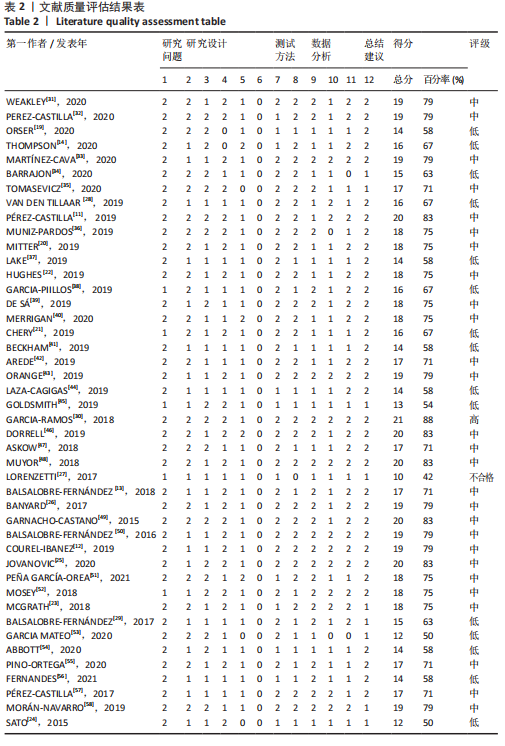
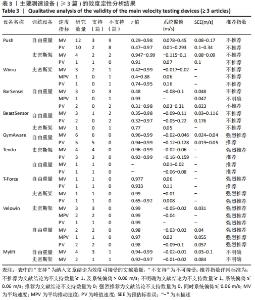
2.3 纳入文献特征 如表3所示,纳入的44篇研究涉及的设备类型包括:7款拉线测速类设备(GymAware,Tendo,T-Force,Speed4lift,FitroDyne,Openbarbell,Chronojump),其中针对GymAware的研究最多(n=6),其次为Tendo(n=5);9款加速度计类测速设备(Push,BeastSensor,iLoad,BarSensei,SmartphoneAccelerator,WIMU,GykoSport,Myotest,Output),其中针对PUSH的研究最多(n=15),其次为BeastSensor(n=4);3款光电摄像(Velowin,FLEX,ElitForm),其中针对Velowin的研究最多(n=6);4款移动端APP类设备(Mylift,Powerlift,iLoad,Iron Path)。鉴于Mylift实际是Powerlift的升级版,因此在分析中将两者合二为一,统一归为Mylift,其相应研究数量为6篇。设备的研发地/产地包括10个国家,数量最多的国家为西班牙(8款,31%),未见中国产品。"
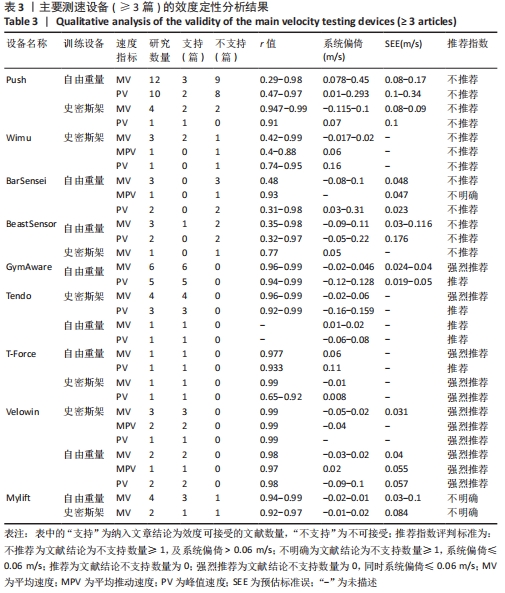

评价的速度指标包括MV(41篇,93%)、PV(28篇,64%)和MPV(7篇,16%)。力量训练使用的器材包括自由重量类(如杠铃,29篇,66%)和固定轨迹类(如史密斯架 ,14篇,32%)。力量训练的动作包括深蹲(30篇,68%)、卧推(19篇,43%)、硬拉(6篇,14%)、深蹲跳(4篇,9%)、肩上推举(2篇,5%)、臀推(1篇,2%)、卧拉(1篇,2%)、俯卧撑(1篇,2%)、高翻(1篇,2%)和二头肌弯举(1篇,2%)。力量训练的强度包括相对强度(32篇,73%)和绝对强度(12篇,27%)。采用 ≥ 3种以上的训练强度的有43篇,仅有1篇采用单一的相对强度。研究采用的金标准多样,27篇研究采用拉线测速设备为金标准(64%),其中9篇采用T-Force(33%),7篇采用GymAware(26%);15篇研究采用三维动作捕捉系统作为金标准(34%),其中7篇采用Vicon系统(47%);剩余的2篇采用测力台作为金标准(5%)。研究间评价效度的指标并不统一,大部分研究采用了皮尔森相关系数r(35篇,80%)、Bland Altman分析中的系统偏倚和/或LoA(34篇,77%),SEE指标(17篇,39%)。 2.4 研究结果分析 速度测量旨在通过速度变化识别练习者的训练水平或状态[59-60]。在同等质量下,MV、PV和MPV分别变化(±0.06-0.08) m/s、(±0.11-0.19) m/s和(±0.08-0.11) m/s时即代表速度出现了有价值的变化[60]。因此,在基于速度的力量训练(velocity based training,VBT)实践中,同等质量下个体MV变化±0.06 m/s或PV变化±0.11 m/s,则需要增加或降低4%-5%1RM负荷,或缩短和延长休息时间30 s[9]。鉴于此,文章除了考虑设备与金标准的相关性(r)之外,同时选取±5%1RM的速度最小变化阈值来评价设备的效度,如果目标设备相对金标准测量MV时的SEE,系统偏倚或LoA明显高于0.06 m/s,测量PV时高于0.11 m/s,则认为其效度不足以进行用于量化力量训练强度。 2.4.1 定性分析结果 有16篇(36%)文献只对加速度计类测速设备进行了效度评价,11篇(69%)文献认为加速度计类设备的效度较低。分别有6篇(14%)和7篇(16%)文献对单一的拉线测速类和光电摄像类测速设备进行了研究,其结论支持二者有高的效度,可用于VBT。有4篇(9%)文献只对APP进行了研究,仅有1篇发现iron path这款移动端APP的效度较低。有6篇(14%)文献两两对比了拉线测速类、加速度计类和移动端APP类测速设备,其结论为拉线测速> APP >加速度计(>表示前者优于后者)。5篇(11%)文献对比了3种以上不同类型的测速设备,均得出拉线测速类和光电摄像类测速设备的效度最高,其次为移动端APP类测速设备,而加速度计类测速设备的效度最低。设备在固定轨迹器械中的效度高于自由重量的器械。拉线测速和光电摄像类在MV中的效度高于PV,具体数据见表3。 2.4.2 荟萃分析结果 经多级分级处理后,最终16篇文献纳入了荟萃分析[11-14,19-30]。较多文献未纳入的原因为:①未提供进行荟萃分析的r值;②对于特定的分组,没有足够数量(< 3篇)的文献进行荟萃分析。以下仅为可进行荟萃分析的研究文献分析结果,见表4,图3-5。 "
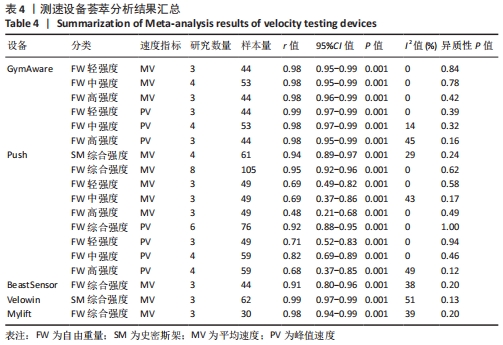

(1) GymAware测量MV的效度 低强度自由重量:总计3项研究的44个样本纳入了该组的荟萃分析[14,20,26]。组内数据呈现低异质性(I 2=0%,τ2=0,P=0.84)。荟萃分析结果表明,GymAware在自由重量低强度力量训练中测量MV与金标准的相关性为优(随机效应模型:r=0.98,95%CI:0.95-0.99,P=0.001),见图3。 中等强度自由重量:总计4项研究的 53个样本纳入了该组的荟萃分析[14,20,26-27]。组内数据呈现低异质性(I2=0%,τ2=0,P=0.78)。荟萃分析结果表明,GymAware在自由重量中等强度力量训练中测量MV与金标准的相关性为优(随机效应模型:r=0.98,95%CI:0.95-0.99,P=0.001),见图3。 高强度自由重量:总计3项研究的44个样本纳入了该组的荟萃分析[14,20,26]。组内数据呈现低异质性(I2=0%,τ2=0,P=0.42)。荟萃分析结果表明,GymAware在自由重量高强度力量训练中测量MV与金标准的相关性为优(随机效应模型:r=0.98,95%CI:0.96-0.99,P=0.001),见图3。 (2) GymAware测量PV的效度 低强度自由重量:总计3项研究的44个样本纳入了该组的荟萃分析[14,20,26]。组内数据呈现低异质性(I2=0%,τ2=0,P=0.39)。荟萃分析结果表明,GymAware在自由重量低强度力量训练中测量PV与金标准的相关性为优(随机效应模型:r=0.99,95%CI:0.97-0.99,P=0.001),见图3。 中等强度自由重量:总计4项研究的53个样本纳入了该组的荟萃分析[14,20,26-27]。组内数据呈现低异质性(I2=14%,τ2=0.019,P=0.32)。荟萃分析结果表明,GymAware在自由重量中强度力量训练中测量PV与金标准的相关性为优(随机效应模型:r=0.98,95%CI:0.97-0.99,P=0.001),见图3。 高强度自由重量:总计3项研究的44个样本纳入了该组的荟萃分析[14,20,26]。组内数据呈现中等异质性(I2=45%,τ2=0.082,P=0.16)。荟萃分析结果表明,GymAware在自由重量中强度力量训练中测量PV与金标准的相关性为优(随机效应模型:r=0.98,95%CI:0.97-0.99,P=0.001),见图3。 (3) Push测量MV的效度 综合强度自由重量:初始纳入9项研究分析[14,19-25,28],组内数据呈中高异质性(I2=62.7%,τ2=0.159,P=0.006),经使用敏感性分析逐个剔除纳入的文献,发现去掉VAN DEN TILLAAR[28]的研究后(n=20)异质性明显降低,再次对该研究的方法学部分细查后,发现其采用的金标准为信效度较低的线性测速设备,其可靠度低于同组其他的研究,因此将其剔除。最后,总计8项研究的 106个样本纳入了该组的荟萃分析[14,19-25]。组内数据呈现低异质性(I2=0%,τ2=0,P=0.62)。荟萃分析结果表明,Push在自由重量综合强度力量训练中测量MV与金标准的相关性为优(随机效应模型:r=0.95,95%CI:0.92-0.96,P=0.001),见图4。 低强度自由重量:总计3项研究的49个样本纳入了该组的荟萃分析[21,26,43]。组内数据呈现低异质性(I2=0%,τ2=0,P=0.58)。荟萃分析结果表明,Push在自由重量低强度力量训练中测量MV与金标准的相关性为中等(随机效应模型:r=0.69,95%CI:0.49-0.82,P=0.001) ,见图5。 中等强度自由重量:总计3项研究的49个样本纳入了该组的荟萃分析[21,26,43]。组内数据呈现中等异质性(I2=43%,τ2=0.07,P=0.17)。荟萃分析结果表明,Push在自由重量中等强度力量训练中测量MV与金标准的相关性为中等(随机效应模型:r=0.69,95%CI:0.37-0.86,P=0.001),见图5。 高强度自由重量:总计3项研究的49个样本纳入了该组的荟萃分析[21,26,43]。组内数据呈现低异质性(I2=0%,τ2=0,P=0.49)。荟萃分析结果表明,Push在自由重量中等强度力量训练中测量MV与金标准的相关性为差(随机效应模型:r=0.48,95%CI:0.21-0.68,P=0.001),见图5。 (4) Push在固定轨迹力量中测量MV综合强度的效度:总计4项研究的61个样本纳入了该组的荟萃分析[12,22,29,57]。组内数据呈现低异质性(I2=29%,τ2=0.034,P=0.24)。荟萃分析结果表明,Push在史密斯架综合强度力量训练中测量MV与金标准的相关性为优(随机效应模型:r=0.94,95%CI:0.89-0.97,P=0.001),见图4。 (5) Push测量PV的效度 综合强度自由重量:初始纳入7项研究分析[14,19-21,24-25,28],组内数据呈中高异质性(I2=61.6%,τ2=0.158,P=0.02),经使用敏感性分析逐个剔除纳入的文献,发现去掉VAN DEN TILLAAR等[28]的研究后(n=20)异质性明显降低,与前述平均速度分析原因一致,所采用金标准可靠性较低,因此剔除。最后,总计6项研究的76个样本纳入了该组荟萃分析[14,19-21,24-25]。组内数据呈现低异质性(I2=0%,τ2=0.019,P=1.00)。荟萃分析结果表明,Push在自由重量综合强度力量训练中测量PV与金标准的相关性为优(随机效应模型:r=0.92,95%CI:0.88-0.95,P=0.001),见图4。 低强度自由重量:总计3项研究的49个样本纳入了该组的荟萃分析[21,26,43]。组内数据呈现低异质性(I2=0%,τ2=0,P=0.94)。荟萃分析结果表明,Push在自由重量低强度力量训练中测量PV与金标准的相关性为中等(随机效应模型:r=0.71,95%CI:0.52-0.83,P=0.001),见图5。 中等强度自由重量:总计4项研究的59个样本纳入了该组的荟萃分析[14,21,26,43]。组内数据呈现低异质性(I2=0%,τ2=0,P=0.46)。荟萃分析结果表明,Push在自由重量低强度力量训练中测量PV与金标准的相关性为良(随机效应模型:r=0.82,95%CI:0.69-0.89,P=0.001),见图5。 高强度自由重量:总计4项研究的59个样本纳入了该组的荟萃分析[14,21,26,43]。组内数据呈现中等异质性(I2=49%,τ2=0.097,P=0.12)。荟萃分析结果表明,Push在自由重量低强度力量训练中测量PV与金标准的相关性为中等(随机效应模型:r=0.68,95%CI:0.37-0.85,P=0.001),见图5。 (6) BeastSensor在自由重量力量训练中测量MV的效度:总计3项研究的44个样本纳入了该组的荟萃分析[14,20,29]。组内数据呈现中等异质性(I2=38%,τ2=0.063,P=0.20)。荟萃分析结果表明,BeastSensor在自由重量综合强度力量训练中测量MV与金标准的相关性为优(随机效应模型:r=0.91,95%CI:0.80-0.96,P=0.001),见图5。 (7) Velowin在固定轨迹力量训练中测量MV的效度:总计3项研究的62个样本纳入了该组的荟萃分析[11-12,30]。组内数据呈现高异质性(I2=51%,τ2=0.065,P=0.13)。荟萃分析结果表明,Velowin在史密斯架综合强度力量训练中测量MV与金标准的相关性为优(随机效应模型:r=0.99,95%CI:0.97-0.99,P=0.001),见图5。 (8) Mylift在自由重量力量训练中测量MV的效度:总计3项研究的 30个样本纳入了该组的荟萃分析[13-14,29]。组内数据呈现中等异质性(I2=39%,τ2=0.09,P=0.20)。荟萃分析结果表明,Mylift在自由重量综合强度力量训练中测量MV与金标准的相关性为优(随机效应模型:r=0.98,95%CI:0.94-0.99,P=0.001),见图5。 "

| [1] PIERCY KL, TROIANO RP. Physical activity guidelines for americans from the US department of health and human services. Circ Cardiovasc Qual Outcomes. 2018; 11(11):e005263. [2] KRAEMER WJ, RATAMESS NA. Fundamentals of resistance training: progression and exercise prescription. Med Sci Sports Exerc. 2004;36(4):674-688. [3] GONZáLEZ-BADILLO JJ, MARQUES MC, SáNCHEZ-MEDINA L. The importance of movement velocity as a measure to control resistance training intensity. J Hum Kinet. 2011;29A:15-19. [4] SINDIANI M, LAZARUS A, IACONO AD, et al. Perception of changes in bar velocity in resistance training: accuracy levels within and between exercises. Physiol Behav. 2020;224:113025. [5] 廖开放,高崇,杨威,等.基于速度的力量训练:应用基础与训练效果[J].上海体育学院学报,2021,45(11):90-104. [6] 陈松,马启伟.动作速度定量控制训练方法的比较学研究-对质量速度曲线的影响[J].北京体育大学学报,1995,18(3): 81-88. [7] 陈松,马启伟.动作速度定量控制发展肌肉速度力量的训练理论与方法[J].北京体育大学学报,1994,17(2):79-90. [8] 闫琪,廖婷,张雨佳.数字化体能训练的理念、进展与实践[J].体育科学,2018, 38(11):5-18. [9] WEAKLEY J, MANN B, BANYARD H, et al. Velocity-based training: from theory to application. Strength cond J. 2020;43(2):31-49. [10] WEAKLEY J, MORRISON M, GARCíA-RAMOS A, et al. The validity and reliability of commercially available resistance training monitoring devices: a systematic review. Sports Med. 2021;51(3):443-502. [11] PéREZ-CASTILLA A, PIEPOLI A, DELGADO-GARCíA G, et al. Reliability and concurrent validity of seven commercially available devices for the assessment of movement velocity at different intensities during the bench press. J Strength Cond Res. 2019; 33(5):1258-1265. [12] COUREL-IBáñEZ J, MARTíNEZ-CAVA A, MORáN-NAVARRO R, et al. Reproducibility and repeatability of five different technologies for bar velocity measurement in resistance training. Ann Biomed Eng. 2019;47(7):1523-1538. [13] BALSALOBRE-FERNáNDEZ C, MARCHANTE D, MUñOZ-LóPEZ M, et al. Validity and reliability of a novel iPhone app for the measurement of barbell velocity and 1RM on the bench-press exercise. J Sports Sci. 2018;36(1):64-70. [14] THOMPSON SW, ROGERSON D, DORRELL HF, et al. The reliability and validity of current technologies for measuring barbell velocity in the free-weight back squat and power clean. Sports (Basel). 2020;8(7):94. [15] 张力为.效度的正用与误用[J].北京体育大学学报,2002,25(4):493-495. [16] LAW MC. Evidence-based Rehabilitation:a Guide to Practice. 2nd ed. Thorofare: Slack Incorporated. 2008. [17] HOPKINS WG, MARSHALL SW, BATTERHAM AM, et al. Progressive statistics for studies in sports medicine and exercise science. Med Sci Sports Exerc. 2009;41(1):3-13. [18] HIGGINS JP, THOMPSON SG, DEEKS JJ, et al. Measuring inconsistency in meta-analyses. Bmj Open. 2003;327(7414):557-560. [19] ORSER K, AGAR-NEWMAN DJ, TSAI MC, et al. The validity of the Push Band 2.0 to determine speed and power during progressively loaded squat jumps. Sports Biomech. 2020;29:1-9. [20] MITTER B, HöLBLING D, BAUER P, et al. Concurrent validity of field-based diagnostic technology monitoring movement velocity in powerlifting exercises. J Strength Cond Res. 2019;35(8):2170-2178. [21] CHéRY C, RUF L. Reliability of the load-velocity relationship and validity of the push to measure velocity in the deadlift. J Strength Cond Res. 2019;33(9):2370-2380. [22] HUGHES LJ, PEIFFER JJ, SCOTT BR. Reliability and validity of using the push band v2.0 to measure repetition velocity in free-weight and smith machine exercises. J Strength Cond Res. 2019;36(3):e81. [23] MCGRATH G, FLANAGAN E, O’DONOVAN P, et al. Velocity based training: validity of monitoring devices to assess mean concentric velocity in the bench press exercise. J Aus Strength Cond. 2018;26(1): 23-30. [24] SATO K, BECKHAM GK, CARROLL K, et al. Validity of wireless device measuring velocity of resistance exercises. J Trainology. 2015;4(1):15-18. [25] JOVANOVIC M, JUKIC I. Within-unit reliability and between-units agreement of the commercially available linear position transducer and barbell-mounted inertial sensor to measure movement velocity. J Strength Cond Res. 2020. doi: 10.1519/JSC.0000000000003776. [26] BANYARD HG, NOSAKA K, SATO K, et al. Validity of various methods for determining velocity, force, and power in the back squat. Int J Sports Physiol Perform. 2017; 12(9):1170-1176. [27] LORENZETTI S, LAMPARTER T, LüTHY F. Validity and reliability of simple measurement device to assess the velocity of the barbell during squats. BMC Res Notes. 2017;10(1):707. [28] VAN DEN TILLAAR R, BALL N. Validity and reliability of kinematics measured with push band vs. linear encoder in bench press and push-ups. Sports (Basel). 2019;7(9):207. [29] BALSALOBRE-FERNáNDEZ C, MARCHANTE D, BAZ-VALLE E, et al. Analysis of wearable and smartphone-based technologies for the measurement of barbell velocity in different resistance training exercises. Front Physiol. 2017;8:649. [30] GARCIA-RAMOS A, PEREZ-CASTILLA A, MARTIN F. Reliability and concurrent validity of the Velowin optoelectronic system to measure movement velocity during the free-weight back squat. In J Sports Sci Coach. 2018;13(5):737-742. [31] WEAKLEY J, CHALKLEY D, JOHNSTON R, et al. Criterion validity, and interunit and between-day reliability of the FLEX for measuring barbell velocity during commonly used resistance training exercises. J Strength Cond Res. 2020;34(6):1519-1524. [32] PÉREZ-CASTILLA A, BOULLOSA D, GARCíA-RAMOS A. Reliability and validity of the iLOAD application for monitoring the mean set velocity during the back squat and bench press exercises performed against different loads. J Strength Cond Res. 2020; 35(suppl 1):s57-s65. [33] MARTíNEZ-CAVA A, HERNáNDEZ-BELMONTE A, COUREL-IBáñEZ J, et al. Reliability of technologies to measure the barbell velocity: implications for monitoring resistance training. PLoS One. 2020;15(6):e0232465. [34] BARRAJON JP, SAN JUAN AF. Validity and reliability of a smartphone accelerometer for measuring lift velocity in bench-press exercises. Sustainability. 2020;12(6):9. [35] TOMASEVICZ CL, HASENKAMP RM, RIDENOUR DT, et al. Validity and reliability assessment of 3-D camera-based capture barbell velocity tracking device. J Sci Med Sport. 2020;23(1):7-14. [36] MUNIZ-PARDOS B, LOZANO-BERGES G, MARIN-PUYALTO J, et al. Validity and reliability of an optoelectronic system to measure movement velocity during bench press and half squat in a Smith machine. Proc Inst Mech Eng Part P-J Sport Eng Technol. 2020;234(1):88-97. [37] LAKE J, AUGUSTUS S, AUSTIN K, et al. The reliability and validity of the bar-mounted PUSH Band(TM) 2.0 during bench press with moderate and heavy loads. J Sports Sci. 2019;37(23):2685-2690. [38] GARCIA-PINILLOS F, LATORRE-ROMAN P A, VALDIVIESO-RUANO F, et al. Validity and reliability of the WIMU (R) system to measure barbell velocity during the half-squat exercise. Proc Inst Mech Eng Part P J Sport Eng Technol. 2019;233(3):408-415. [39] DE Sá EC, RICARTE MEDEIROS A, SANTANA FERREIRA A, et al. Validity of the iLOAD® app for resistance training monitoring. Peer J. 2019;7:e7372. [40] MERRIGAN JJ, MARTIN JR. Is the OUTPUT sports unit reliable and valid when estimating back squat and bench press concentric velocity? J Strength Cond Res. 2020. doi:10.1519/JSC.0000000000003782. [41] BECKHAM GK, LAYNE DK, KIM SB, et al. Reliability and criterion validity of the assess perform bar sensei. Sports (Basel). 2019;7(11):230. [42] AREDE J, FIGUEIRA B, GONZALO-SKOK O, et al. Validity and reliability of Gyko Sport for the measurement of barbell velocity on the bench-press exercise. J Sports Med Phys Fit. 2019;59(10):1651-1658. [43] ORANGE ST, METCALFE JW, LIEFEITH A, et al. Validity and reliability of a wearable inertial sensor to measure velocity and power in the back squat and bench press. J Strength Cond Res. 2019;33(9):2398-2408. [44] LAZA-CAGIGAS R, GOSS-SAMPSON M, LARUMBE-ZABALA E, et al. Validity and reliability of a novel optoelectronic device to measure movement velocity, force and power during the back squat exercise. J Sports Sci. 2019;37(7):795-802. [45] GOLDSMITH JA, TREPECK C, HALLE JL, et al. Validity of the open barbell and tendo weightlifting analyzer systems versus the optotrak certus 3D motion-capture system for barbell velocity. Int J Sports Physiol Perform. 2019;14(4):540-543. [46] DORRELL HF, MOORE JM, SMITH MF, et al. Validity and reliability of a linear positional transducer across commonly practised resistance training exercises. J Sports Sci. 2019;37(1):67-73. [47] ASKOW AT, STONE JD, ARNDTS DJ, et al. Validity and reliability of a commercially-available velocity and power testing device. Sports (Basel). 2018;6(4):170. [48] MUYOR JM, GRANERO-GIL P, PINO-ORTEGA J. Reliability and validity of a new accelerometer (Wimu((R))) system for measuring velocity during resistance exercises. Proc Inst Mech Eng Part P J Sport Eng Technol. 2018;232(3):218-224. [49] GARNACHO-CASTANO MV, LOPEZ-LASTRA S, MATE-MUNOZ JL. Reliability and validity assessment of a linear position transducer. J Sport Sci Med. 2015;14(1):128-136. [50] BALSALOBRE-FERNáNDEZ C, KUZDUB M, POVEDA-ORTIZ P, et al. Validity and reliability of the Push wearable device to measure movement velocity during the back squat exercise. J Strength Cond Res. 2016;30(7):1968-1974. [51] PEñA GARCíA-OREA G, BELANDO-PEDREñO N, MERINO-BARRERO JA, et al. Validation of an opto-electronic instrument for the measurement of execution velocity in squat exercise. Sports Biomech. 2021; 20(6):706-719. [52] MOSEY TJ, BROWN W, WATTS DG, et al. Reliability and validity of the ‘elite form’ 3d motion capturing system. J Aus Strength Cond. 2018;26(5):1-14. [53] GARCIA MATEO P. Measurement of a squat movement velocity: comparison between a RehaGait accelerometer and the high-speed video recording method called MyLift. J Physi Education Sports (Basel). 2020;20(3):1343-1353. [54] ABBOTT JC, WAGLE JP, SATO K, et al. Validation of inertial sensor to measure barbell kinematics across a spectrum of loading conditions. Sports (Basel). 2020; 8(7):93. [55] PINO-ORTEGA J, BASTIDA-CASTILLO A, HERNANDEZ-BELMONTE A, et al. Validity of an inertial device for measuring linear and angular velocity in a leg extension exercise. Proc Inst Mech Eng Part P J Sport Eng Technol. 2020;234(1):30-36. [56] FERNANDES JFT, LAMB KL, CLARK CCT, et al. Comparison of the fitrodyne and gymaware rotary encoders for quantifying peak and mean velocity during traditional multijointed exercises. J Strength Cond Res. 2021;35(6):1760-1765. [57] PéREZ-CASTILLA A, FERICHE B, JARIC S, et al. Validity of a linear velocity transducer for testing maximum vertical jumps. J Appl Biomech. 2017;33(5):388-392. [58] MORáN-NAVARRO R, MARTíNEZ-CAVA A, SáNCHEZ-MEDINA L, et al. Movement velocity as a measure of level of effort during resistance exercise. J Strength Cond Res. 2019;33(6):1496-1504. [59] KASOVIC J, MARTIN B, CARZOLI JP, et al. Agreement between the iron path app and a linear position transducer for measuring average concentric velocity and range of motion of barbell exercises. J Strength Cond Res. 2021;35(Suppl 1):S95-S101. [60] BANYARD HG, NOSAKA K, HAFF GG. Reliability and validity of the load-velocity relationship to predict the 1RM back squat. J Strength Cond Res. 2017;31(7):1897-1904. [61] ORANGE ST, METCALFE JW, MARSHALL P, et al. Test-retest reliability of a commercial linear position transducer (GymAware PowerTool) to measure velocity and power in the back squat and bench press. J Strength Cond Res. 2020;34(3):728-737. [62] 王欢,王馨塘,佟海青,等.三种加速度计测量多种身体活动的效度比较[J].体育科学,2014,34(5):45-50. [63] ALCAZAR J, CSAPO R, ARA I, et al. On the shape of the force-velocity relationship in skeletal muscles: the linear, the hyperbolic, and the double-hyperbolic. Front Physiol. 2019;10:769. [64] 黎涌明,韩甲,等.我国运动训练学亟待科学化——青年体育学者共识[J].上海体育学院学报,2020,44(2):39-52. |
| [1] | Liu Xinyue, Xing Xinyang, Huo Hongfeng. Differences in human dynamic stability during walking under different cognitive loads [J]. Chinese Journal of Tissue Engineering Research, 2023, 27(9): 1335-1339. |
| [2] | Zhang Yan, He Ruibo, Wang Qingbo, Pi Yihua, Lu Chunmin, Xu Chuanyi, Ma Gang, Peng Peng. Effects of aerobic exercises with different load volumes on inflammatory response and insulin signaling pathway of skeletal muscle in obese rats [J]. Chinese Journal of Tissue Engineering Research, 2023, 27(8): 1237-1244. |
| [3] | Sun Jiangwei, Wang Junxiang, Baibujiafu·Yellisi, Dai Huijuan, Nijati·Turson. Three-dimensional finite element analysis of stress distribution in different smooth collar implants [J]. Chinese Journal of Tissue Engineering Research, 2023, 27(7): 1004-1011. |
| [4] | Liu Qinghua, Cai Yongqiang, Jin Feng, Yu Jinghong, Wang Haiyan, Zhang Yunfeng, Wang Lidong, Li Jiawei, Wang Xing, He Yujie, Dai Lina, Wang Jianzhong, Wu Chao, Tong Ling, Kang Zhijie, Li Zhijun, Li Xiaohe. Finite element model of the 12-year-old child whole cervical spine: establishment and validity verification based on CT data [J]. Chinese Journal of Tissue Engineering Research, 2023, 27(4): 500-504. |
| [5] | Wang Junxiang, Sun Jiangwei, Bai Bujiafu·Yellisi, Wang Zhaoxin, Nijati·Turson. Effect of three abutment materials on bone stress around maxillary angle implant under dynamic loading [J]. Chinese Journal of Tissue Engineering Research, 2023, 27(3): 398-405. |
| [6] | Han Tao, Hao Jianqiang, Li Wenbo, Shi Jie, Gao Qiuming. Advantages and problems of antibiotic-loaded bone cements for bone and joint infections [J]. Chinese Journal of Tissue Engineering Research, 2023, 27(3): 470-477. |
| [7] | Liu Peina, Li Yuanming, Fan Zhiyong. Mechanical characteristics of stepping lumbus of fixed-point at lateral decubitus position under different pushing modes collected using multi-point membrane pressure test system [J]. Chinese Journal of Tissue Engineering Research, 2022, 26(35): 5577-5582. |
| [8] | Lin Lingqi, Chen Jin, Qian Kun, Zhao Liang, Shi Yijie. Preparation and in vitro release of manganese-based metal-organic framework materials loaded with baicalin [J]. Chinese Journal of Tissue Engineering Research, 2022, 26(34): 5475-5481. |
| [9] | He Yujie, Li Pei, Xue Mingming, Li Zhijun, Li Xiaohe, Wang Xing, Gao Mingjie, Wu Chao, Kang Zhijie, Zhang Shaojie, Wang Haiyan. Establishment and validation of finite element model of cervical facet joint in children [J]. Chinese Journal of Tissue Engineering Research, 2022, 26(33): 5265-5270. |
| [10] | Chen Xi, Cheng Hui, Chen Jiahui, Li Xiurong. Clinical applicability of cobalt-chromium metal-ceramic crowns with porcelain margin [J]. Chinese Journal of Tissue Engineering Research, 2022, 26(27): 4374-4378. |
| [11] | Zhang Mi, Wu Saixuan, Dong Ming, Liu Tingjiao, Niu Weidong. Novel nano-delivery system: engineered small extracellular vesicles [J]. Chinese Journal of Tissue Engineering Research, 2022, 26(27): 4417-4422. |
| [12] | Li Gaofeng, Wang Jun. Effects of concurrent aerobic and strength training on locomotor performance: a Meta-analysis [J]. Chinese Journal of Tissue Engineering Research, 2022, 26(26): 4258-4264. |
| [13] | Liang Meifu, Guo Wenxia, Zhao Ningning, Pan Lei. Determination and characteristics of skeletal muscle output power in different strength training methods under optimal power load [J]. Chinese Journal of Tissue Engineering Research, 2022, 26(23): 3638-3643. |
| [14] | Jiang Chaorui, Xu Yan, Xiong Ying, Zhang Xujing. Preparation and properties of graphene oxide/silk fibroin/rifampicin drug-loading microspheres [J]. Chinese Journal of Tissue Engineering Research, 2022, 26(22): 3467-3473. |
| [15] | Xie Fei, Jia Peng, Liu Jiaxin, Liu Lu, Zhang Chunqiu, Ye Jinduo. Effect of loading mode on stress distribution in head and neck of the femoral stem [J]. Chinese Journal of Tissue Engineering Research, 2022, 26(15): 2302-2306. |
| Viewed | ||||||
|
Full text |
|
|||||
|
Abstract |
|
|||||
